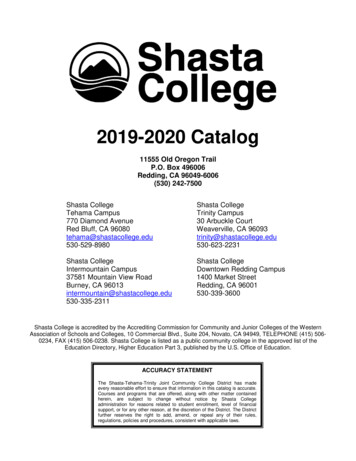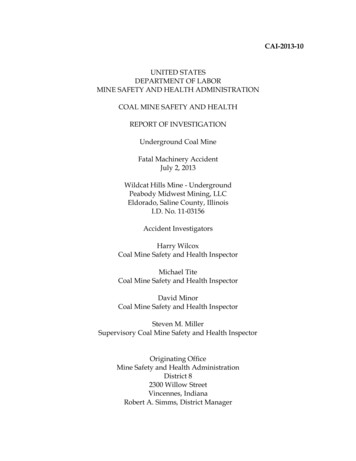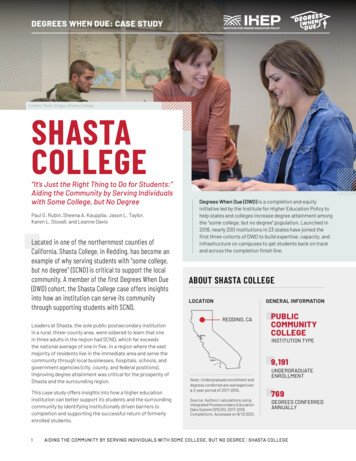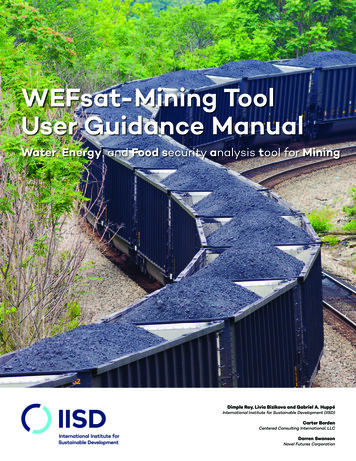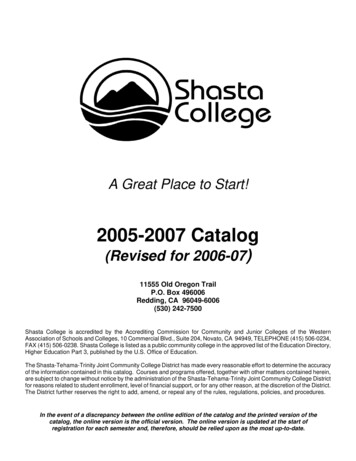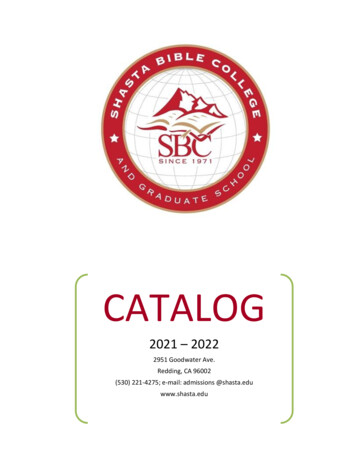
Transcription
CASE STUDYGolinsky MineShasta County, CaliforniaAugust 2010Prepared byThe Interstate Technology & Regulatory CouncilMining Waste Team
Permission is granted to refer to or quote from this publication with the customaryacknowledgment of the source. The suggested citation for this document is as follows:ITRC (Interstate Technology & Regulatory Council). 2010. Golinsky Mine, Shasta County,California. Mining Waste Treatment Technology Selection Web. Washington, D.C.:Interstate Technology & Regulatory Council, Mining Waste Team. www.itrcweb.org.AcknowledgementsThe ITRC Mining Waste Team would like to acknowledge Philip Woodward from CaliforniaRegional Water Quality Control Board, who completed the April 2008 Mine Waste Case StudySurvey, from which the information in this case study is taken.
TABLE OF CONTENTS1. SITE INFORMATION .11.1 Contacts . 11.2 Name, Location, and Description. 12. REMEDIAL ACTION AND TECHNOLOGIES .23. PERFORMANCE .24. COSTS .35. REGULATORY CHALLENGES .36. STAKEHOLDER CHALLENGES .37. OTHER CHALLENGES AND LESSONS LEARNED .38. REFERENCES .3LIST OF FIGURESFigure 1-1. Site location nap . 1LIST OF TABLESTable 3-1. Cleanup concentrations . 2i
GOLINSKY MINE, SHASTA COUNTY, CALIFORNIA1.SITE INFORMATION1.1ContactsBrad ShipleyU.S. Forest ServiceTelephone: 530-478-6185E-mail: bshipley@fs.fed.us1.2Name, Location, and DescriptionThe Golinsky Copper Mine operated between 1890s and 1930s. The mine is in Sections 28 and33, T34N, R5W, MDB&M (Figure 1-1). Three portals discharge acid mine drainage (AMD) toLittle Backbone Creek, which is tributary to Shasta Lake. Sulfide ore was mined and smelted onsite. The area is at edge of the Klamath Mountains U.S. Forest Service property and isapproximately 20 acres. Access is limited to boat and ATV. Two portals seals have beeninstalled with limited success.Figure 1-1. Site location lifornia-Golinsky Mine.html)Inspections by staff from 1978 to 1991 revealed pH ranging 2.8–3.5, copper ranging 8.6–17.6 mg/L, zinc ranging 16.8–78 mg/L, and cadmium 0.18–1.5 mg/L in discharges from theportals. Federal effluent limits for copper, zinc and cadmium at that time were 0.3, 1.5, and
ITRC – Golinsky Mine, Shasta County, CaliforniaAugust 20100.1 mg/L, respectively (California Regional Water Quality Control Board, Central ValleyRegion, 98-701).2.REMEDIAL ACTION AND TECHNOLOGIESThe remedial action is to provide for the mitigation of ecological risk using sulfide and carbonateprecipitation via sulfate-reducing bacteria.Concrete bulkhead seals were originally placed in two portals in the hopes of preventing thedischarge of AMD. The workings were too shallow and the host rock too fractured to adequatelycontain the AMD. A third portal was clean/neutral prior to the bulkheads and has returned toclean since the bulkhead valves were opened and remained so for one year. Discharge from theupper and lower portals is collected in pipes, diverted around the waste piles and mine ravine to atank and flume, and discharged back into the ravine just before it enters Little Backbone Creek.Spring and fall monitoring and periodic inspections of equipment continue.A final design is near completion for a long-term higher capacity treatment system consisting ofthree parallel cells with a design plan of 10 gpm per cell. Construction of the first cell will beginas soon as a source of funding is obtained. Bankruptcy negotiations with PRP ASARCOcontinue. Since there is no infrastructure (roads, electricity, etc.) near the site to support aconventional treatment system, a “passive” treatment system was the best alternative.Three ponds will be filled with organic material to support anaerobic sulfate-reducing bacteria.The acid mine drainage will flow vertically through the pond, where the metals will precipitateout as sulfides in the media. A pilot-scale sulfate-reducing bioreactor treated 1 gpm, and the fullscale proposal is to treat 10 gpm.The bench pilot test cell using a moderate amount of rice hulls as the test medium yielded thebest results. A full-scale pipeline (6-inch high-density polyethylene) was built to the limestonequarry, then reduced to a temporary 1-inch line for the last 50 feet to feed the pilot cellbioreactor. In July 2004, the first samples were taken, and the analytical results indicate thesystem is functioning as expected.3.PERFORMANCEThe goal is to reduce metals in the discharge sufficiently to support aquatic life overall in LittleBackbone Creek, Shasta Lake, and the Sacramento River. The state is attempting to rely onapplication of best management practices to reduce the discharge of metals from abandonedmines in place of requiring numeric effluent limits (Table 3-1).Table 3-1. Cleanup concentrationsContaminantTarget cleanup levelAcid mine drainageCadmium, copper, iron, and zinc 99% removal each2
ITRC – Golinsky Mine, Shasta County, CaliforniaAugust 2010The treatment cell achieved 99% removal of all the target metals and raised the pH to acceptablelevels.4.COSTSCost of activities at this site are reported as a total: Capital: 1,700,000Operation and maintenance: 65,000/yr5.REGULATORY CHALLENGESIt is unlikely the effluent will consistently meet the state or federal requirements for discharge tosurface waters. However, the U.S. Forest Service claims it is not held to strict state standards asit can waive certain applicable, relevant, and appropriate requirements using its position underCERCLA. The state is attempting to rely on application of best management practices to reducethe discharge of metals from abandoned mines in place of requiring numeric effluent limits.6.STAKEHOLDER CHALLENGESNone reported.7.OTHER CHALLENGES AND LESSONS LEARNEDConcrete bulkhead seals were originally placed in the portals in the hopes of preventing thedischarge of AMD. The workings were too shallow and the host rock too fractured to adequatelycontain the AMD. Since there is no infrastructure (roads, electricity, etc.) near the site to supporta conventional treatment system, a “passive” treatment system was the best alternative.8.REFERENCESNote: 2008 Action Memo, design documents, and current monitoring reports are all maintainedin the Administrative Record on the Shasta Trinity National Forest in Redding. Contact: BradShipleyCalifornia Regional Water Quality Control Board, Central Valley Region. 1998. “Cleanup andAbatement Order for U.S. Department of Agriculture Forest Service, Shasta-Trinity NationalForest, Golinsky Mine, Shasta County.” Order No. 98-701.Department of Conservation California, Abandoned Mine Lands Forum. 2004. “August 11, d mine %2004%20notes%20final.pdf.3
The Golinsky opper C Mine operated between 1890s and 1930s.The mine is in Sections 28 and 33, T34N, R5W, MDB&M (Figure 1-1). Three portals discharge acid mine drainage (AMD) to Little Backbone Creek, which is tributary to Shasta Lake.Sulfide ore was mined and smelted on
